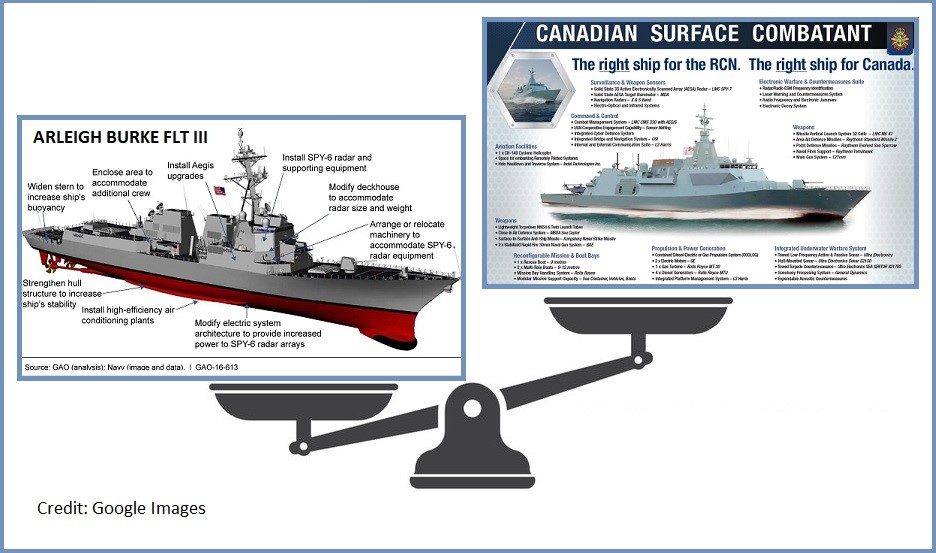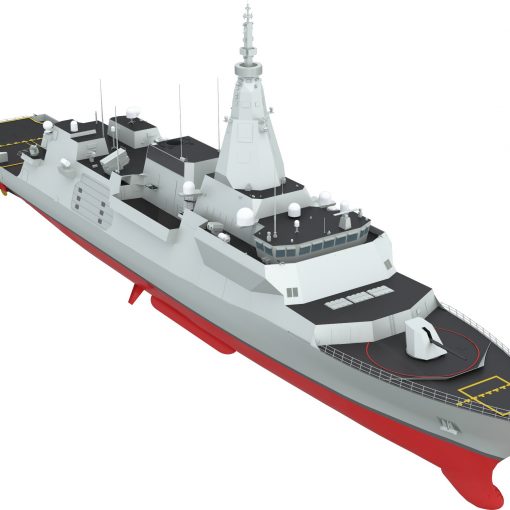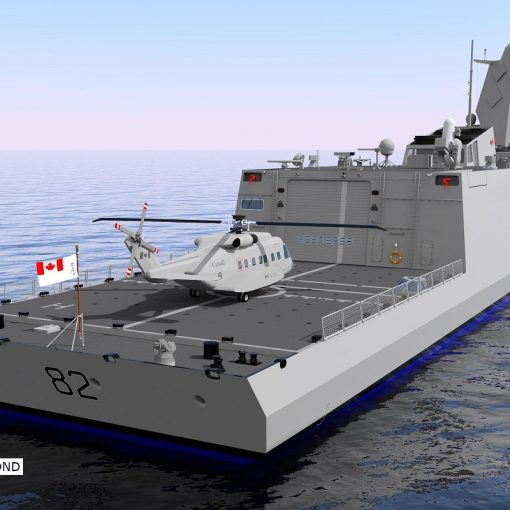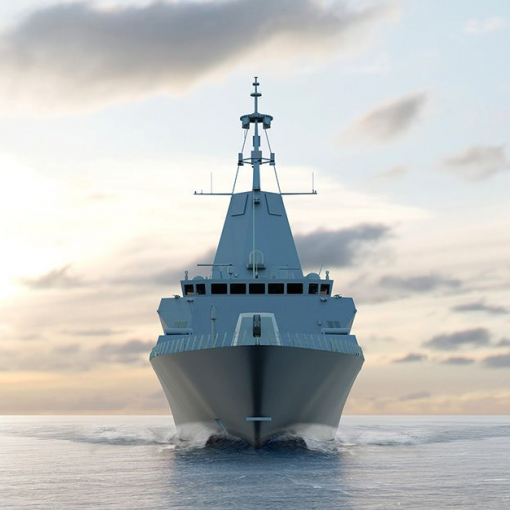Procrustes, 19 February 2021
Supporters of the Canadian Surface Combatant (CSC) argue that Canadians, including the Parliamentary Budget Officer (PBO), should not compare the projected CSC costs with those of other frigates currently in service or being developed because the CSC will have far superior capabilities in sensor suites and weapons load-outs to these other warships.[1]
Fair enough, perhaps, so let us compare the CSC proposed capabilities with a similar warship. Take, for example, the US Navy’s successful destroyer, the Arleigh Burke-class (DDG-51). Before objections roll in saying we cannot compare a mere frigate to a destroyer, let us examine the facts. What is in a name, after all? The Flight IIA Arleigh Burkes (with the entire series now nearing completion) are 155 metres long, 20.3 metres in beam, and have a maximum draught of 9.7 metres. The Flight IIAs have a fully loaded weight of 9,500 tons. The only concrete information regarding the CSC design gives the following: 151.4 metres long, 20.75 metres beam, navigational draught of about 8 metres. According to Kevin McCoy, the former President of Irving Shipbuilding, the full displacement weight of the CSC will be about 9,400 tonnes.[2] Moreover, leaving aside quibbles about what constitutes the true ‘ship costs,’ the DDG 51s and CSC will cost about the same per ship.
OK, so these two ships are approximately the same in size and weight for the purpose of this discussion. Now, how do the capabilities compare for these two roughly similar warships? There is a major difference here: the Arleigh Burkes have vastly superior payloads with 96 Mark 41 Vertical Launch Systems (VLS) cells as opposed to the CSC’s 32 cells. The former also carry the RIM-161 Standard Missile 3 (SM-3) designed to intercept ballistic missiles in outer space; the CSC will not carry this particular missile. Most of the other missiles carried by each ship are the same.
The Arleigh Burkes are also much faster than the CSC is projected to be, being propelled by four upgraded LM2500 gas turbine engines, each rated at over 30 MW. The CSC will be propelled by a single Rolls Royce MT 30 gas turbine rated at 36 MW. The DDG-51 can exceed 30 knots top speed, while the CSC will almost certainly have a slower top speed at its currently estimated weight.
A key point here is that with only 32 VLS cells, the CSC resides at the low end of most comparable warships of its size and weight. And that is now, not 12-15 years from now when, and if, these ships first enter service and when we might expect greater numbers of VLS cells on similar warships. Because of this, one may speculate that on missions with real conflict potential, the CSC will be fully loaded with predominantly defensive missiles rather than those which could carry the fight to an adversary. After all, for Ottawa a multi-billion dollar warship is far too valuable to risk losing. So, we could end up with warships that spend a good deal of their time defending themselves. So why send them into harm’s way in the first place?
Another irony lies in the open speculation that Canada’s expensive and large CSC will have to jettison many of the advanced sensors and weapons that planners have designed into in it in at least an initial batch of these warships. In short, this program, which Alan Williams implies is totally out of control,[3] may have to scupper many of its sophisticated features in order to reduce
costs in order to secure political approval in Ottawa. Talk about a self-defeating process leading to a paper tiger of a warship!
This seeming paradox has caught the attention of a well respected analyst in Australia, who has raised the issue of the operational implications of the limited payload capacity of Australia’s Hunter-class frigates – a similar class to Canada’s proposed CSC.[4] I will not delve into the details here, but this article is well worth reading!
Put simply, the question is what will Canada really be getting in this big, expensive warship? Perhaps not as much as its supporters contend. Big bucks, little bang...
Notes
1. See, for example, the Naval Association of Canada, “The National Shipbuilding Strategy and the Canadian Surface Combatant”, (2021), 11.
2. Murray Brewster, “It will be at least a decade before Canada sees any of its new frigates”, CBC News, (13 February 2021). Accessed at: https://www.cbc.ca/news/politics/canada-shipbuilding-decade-frigates-1.5912961
3. David Pugliese, “DND unable to say exactly when delays in $70-billion warship program began”, Ottawa Citizen, (16 February 2021). Accessed at: https://ottawacitizen.com/news/national/defence-watch/dnd-unable-to-say-exactly-when-delays-in-70-billion-warship-program-began
4. Marcus Hellyer, “Does the Royal Australian Navy need Tomahawk missiles?”, The Strategist, (16 February 2021). Accessed at: https://www.aspistrategist.org.au/does-the-royal-australian-navy-need-tomahawk-missiles/






8 thoughts on “CSC: Paper Tiger?”
I believe, if not mistaken, the SM-3 can still be fitted in the CSC MK 41 VLS containers (fitted for but not with) in case Ottawa changes its mind on Ballistic Missile Defence (BMD) for the possible future.
Believe you’re wrong on the SM-3.The panic on the CSC is comparable to the media invited were invited on Bonaventure AFTER rumors of her demise began. Another public affairs fail.
Do some research, the SM 3 can be fired from the MK 41.
https://en.wikipedia.org/wiki/Mark_41_Vertical_Launching_System
Agree Ted. Just wanted to see if Dave agreed.
Hi Dave! Good to hear from you. Can you confirm on the SM-3? Cheers!
Yes, the MK 41 VLS can carry the SM-3, but this was not the point. The CSC is not slated to carry this missile. For what it is worth, I do not believe any government in Ottawa, no matter what the political stripe, is going to be getting Canada into ballistic missile defence any time soon.
At least not until the next election….maybe.
Hello,
In the same vein, https://www.thechronicleherald.ca/news/local/price-tag-on-frigate-replacements-to-be-built-in-halifax-could-hit-80-billion-analyst-555801/ Tomahawk missiles.
So, land attack missiles against China and Russia (note that these countries are almost formal military allies), with Tomahawk missiles, requires some math (from Wikipedia):
Tomahawk
Speed: Mach 0.74
Range: 1,300km – 2,500 km
LRASM
Speed: <Mach 1.0
Range: 560km
ESSM
Speed: Mach 4.0
Range: 50km
CAMM
Speed: Mach 3.0
Range: <50km
NSM
Speed: <Mach 1.0
Range: 185km – 555km
SM-2
Speed: Mach 3.5
Range: 167km
SM-3
Ballistic missile intercept, limited effectiveness against targets manoeuvring along non-ballistic flight paths
Speed: Mach 10 – Mach 18
Range: 900km – 1,200km
Going against adversaries acting within 1,000km of their coast (China's first island chain for example) armed with:
3M22 Zirkon
Speed: Mach 8 – Mach 9
Range: 1,000km – 2,000km
Kh-47M2 Kinzhal
Speed: Mach 10 – Mach 12
Range: 2,000km – 3,000km
Dongfeng-17
Speed: Mach 5
Range: 1,800km – 2,500km
9M730 Burevestnik and Avangard, following non-ballistic trajectories with unlimited range.
Whatever we may think of our expensive tigers, the speed/range math looks bad.